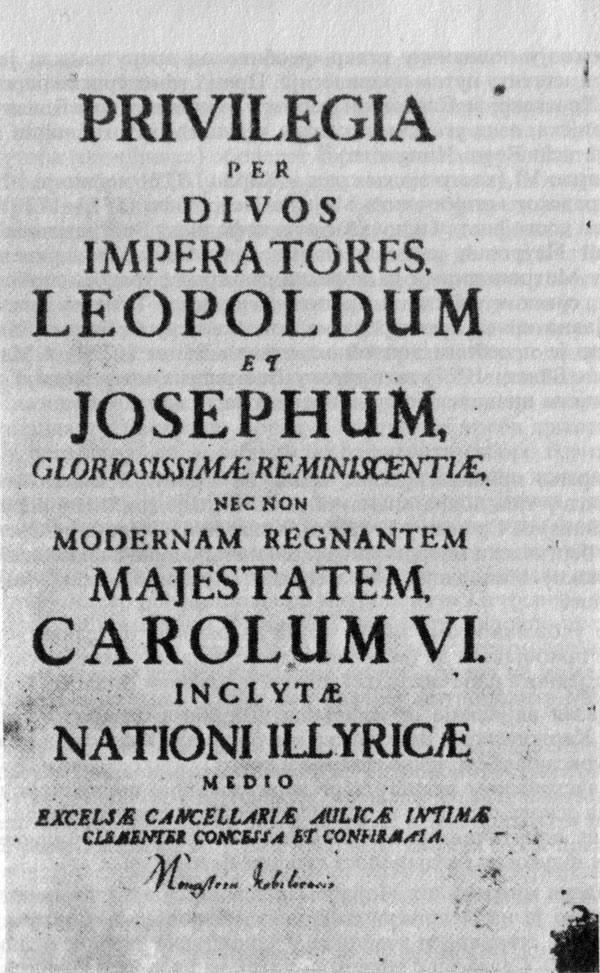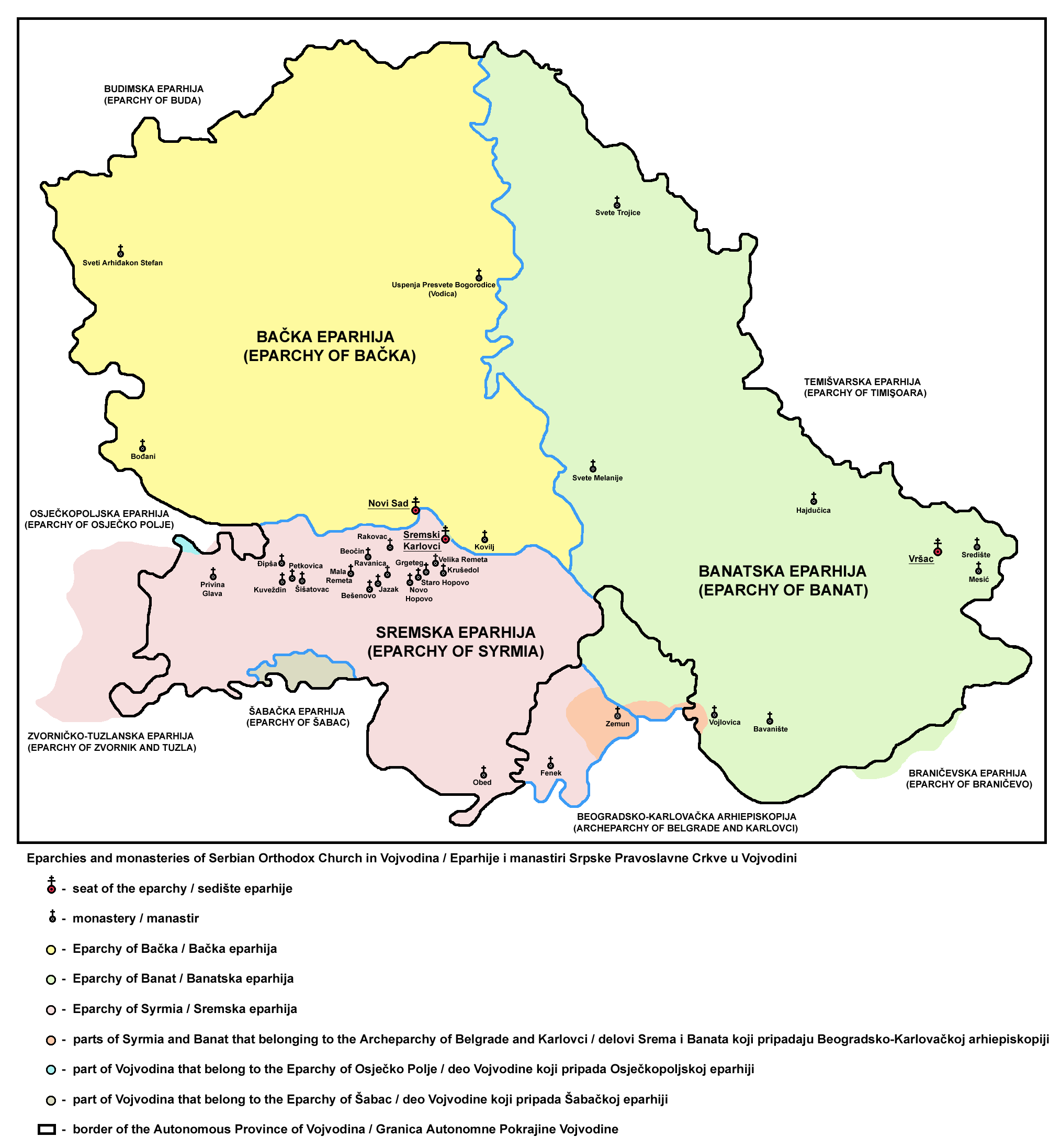|
Joakim Marković
Joakim Marković (c. 1685–1757) was an Austrian Serb painter who worked in Old Slavonia. He painted the iconostasis of two bishopric churches in Pakrac and Severin County, and in St. Thomas Church in Dišnik (now Garesnica in the Bjelovar-Bilogora County). Artistically and historically Marković's most interesting iconostasis is the memorial church built by a Serbian military border officer, Baron Mihailo Mikašinović in Plavšinac. In Plavšinac, Joakim Marković painted two compositions in 1750, one showing the privileges bestowed by Byzantine emperor Basil II on the Serbs and Croats - the privilege of establishing themselves in his dominion. That painting is now in Zagreb. The second Marković's painting shows the Austrian monarch Rudolf II with Serbs. These paintings are considered the first historical compositions in our recent art. Marković painted primarily religious-themed icons and frescoes. He did frescoes for the Metropolitanate of Karlovci in the church monasterie ... [...More Info...] [...Related Items...] OR: [Wikipedia] [Google] [Baidu] |
Slavonia
Slavonia (; hr, Slavonija) is, with Dalmatia, Croatia proper, and Istria, one of the four historical regions of Croatia. Taking up the east of the country, it roughly corresponds with five Croatian counties: Brod-Posavina, Osijek-Baranja, Požega-Slavonia, Virovitica-Podravina, and Vukovar-Syrmia, although the territory of the counties includes Baranya, and the definition of the western extent of Slavonia as a region varies. The counties cover or 22.2% of Croatia, inhabited by 806,192—18.8% of Croatia's population. The largest city in the region is Osijek, followed by Slavonski Brod and Vinkovci. Slavonia is located in the Pannonian Basin, largely bordered by the Danube, Drava, and Sava rivers. In the west, the region consists of the Sava and Drava valleys and the mountains surrounding the Požega Valley, and plains in the east. Slavonia enjoys a moderate continental climate with relatively low precipitation. After the fall of the Western Roman Empire, whi ... [...More Info...] [...Related Items...] OR: [Wikipedia] [Google] [Baidu] |
Pakrac
Pakrac is a town in western Slavonia, Croatia, population 4,842, total municipality population 8,460 (census 2011). Pakrac is located on the road and railroad connecting the regions of Posavina and Podravina. Name In Croatian the town is known as ''Pakrac'', in German as ''Pakratz'', in Hungarian as ''Pakrác''. History The town was first mentioned in 1237. It was captured by the Ottoman Empire in 1543. It was initially a kaza centre in the Sanjak of Pojega between 1543 and 1552, then in the Sanjak of Pakrac in the Rumelia Eyalet between 1552 and 1559. Later it was the centre of the Sanjak of Pakrac between 1559 and 1601, when the sanjak seat was moved to Cernik. The Ottoman rule in Pakrac lasted until the Austrians captured it in 1691. In the late 19th and early 20th centuries, Pakrac was part of the Požega County of the Kingdom of Croatia-Slavonia. Hostilities during the Yugoslav wars in Pakrac began on August 18, 1991, when Serb troops shelled the town from positions in t ... [...More Info...] [...Related Items...] OR: [Wikipedia] [Google] [Baidu] |
Severin County
Severin County was a county ( Romanian: '' județ'') in the Kingdom of Romania, in the historical region of the Banat. Its capital was Lugoj. Severin County was established in 1926, disbanded with the administrative reform of 1938, re-created in 1940, and finally disbanded with the administrative reform of 1950. Geography Severin County covered 6,422 km2 and was located in the south-western part of Greater Romania, in the eastern part of the Banat. Currently, the territory that comprised Severin County is divided between Timiș, Caraș-Severin, Arad and Mehedinți counties. In the interwar period, the county neighbored Caraș and Timiș-Torontal counties to the west, Arad County to the north, Hunedoara County to the east, Mehedinți County to the southeast, and Kingdom of Yugoslavia to the south. Administrative organization Administratively, Severin County was originally divided into six districts ('' plăși''): #Plasa Birchiș, headquartered at Birchiș #Plasa C ... [...More Info...] [...Related Items...] OR: [Wikipedia] [Google] [Baidu] |
Dišnik
Dišnik is a village in Croatia , image_flag = Flag of Croatia.svg , image_coat = Coat of arms of Croatia.svg , anthem = "Lijepa naša domovino"("Our Beautiful Homeland") , image_map = , map_caption = , capit .... It has about 343 residents and is situated northeast of Velika Bršljanica. References Populated places in Bjelovar-Bilogora County {{BjelovarBilogora-geo-stub ... [...More Info...] [...Related Items...] OR: [Wikipedia] [Google] [Baidu] |
Bjelovar-Bilogora County
Bjelovar-Bilogora County (; hr, Bjelovarsko-bilogorska županija ) is a county in central Croatia. The central town of Bjelovar was first mentioned in 1413, and it only gained importance when a new fort was built in 1756 to defend against the Ottoman invasions. The town was pronounced a free royal town in 1874. The other part of the county name is for the hill of Bilogora that stretches along the northern edge of the county. Other towns in the county are Daruvar, Garešnica, Čazma and Grubišno Polje. The Bjelovar-Bilogora County borders on the Koprivnica-Križevci County in the north, Virovitica-Podravina County in the northeast, Požega-Slavonia County in the southeast, Sisak-Moslavina County in the southwest and Zagreb County in the west. Alongside the City of Zagreb and Požega-Slavonia County, it is the only Croatian county that does not border another nation. Administrative division Bjelovar-Bilogora County is further divided into 5 towns and 18 municipaliti ... [...More Info...] [...Related Items...] OR: [Wikipedia] [Google] [Baidu] |
Basil II
Basil II Porphyrogenitus ( gr, Βασίλειος Πορφυρογέννητος ;) and, most often, the Purple-born ( gr, ὁ πορφυρογέννητος, translit=ho porphyrogennetos).. 958 – 15 December 1025), nicknamed the Bulgar Slayer ( gr, ὁ Βουλγαροκτόνος, ),). and believe the epithet to have entered common usage among the Byzantines at the end of the 12th century, when the Second Bulgarian Empire broke away from Byzantine rule and Basil's martial exploits became a theme of Imperial propaganda. It was used by the historian Niketas Choniates and the writer Nicholas Mesarites, and consciously inverted by the Bulgarian ruler Kaloyan, who called himself "Roman-slayer" ( gr, Ρωμαιοκτόνος, translit=Rhomaioktonos). was the senior Byzantine emperor from 976 to 1025. He and his brother Constantine VIII were crowned before their father Romanos II died in 963, but they were too young to rule. The throne thus went to two generals, Nikepho ... [...More Info...] [...Related Items...] OR: [Wikipedia] [Google] [Baidu] |
Zagreb
Zagreb ( , , , ) is the capital and largest city of Croatia. It is in the northwest of the country, along the Sava river, at the southern slopes of the Medvednica mountain. Zagreb stands near the international border between Croatia and Slovenia at an elevation of approximately above sea level. At the 2021 census, the city had a population of 767,131. The population of the Zagreb urban agglomeration is 1,071,150, approximately a quarter of the total population of Croatia. Zagreb is a city with a rich history dating from Roman times. The oldest settlement in the vicinity of the city was the Roman Andautonia, in today's Ščitarjevo. The historical record of the name "Zagreb" dates from 1134, in reference to the foundation of the settlement at Kaptol in 1094. Zagreb became a free royal city in 1242. In 1851 Janko Kamauf became Zagreb's first mayor. Zagreb has special status as a Croatian administrative division - it comprises a consolidated city-county (but separate from ... [...More Info...] [...Related Items...] OR: [Wikipedia] [Google] [Baidu] |
Rudolf II, Holy Roman Emperor
Rudolf II (18 July 1552 – 20 January 1612) was Holy Roman Emperor (1576–1612), King of Hungary and Croatia (as Rudolf I, 1572–1608), King of Bohemia (1575–1608/1611) and Archduke of Austria (1576–1608). He was a member of the House of Habsburg. Rudolf's legacy has traditionally been viewed in three ways:Hotson, 1999. an ineffectual ruler whose mistakes led directly to the Thirty Years' War; a great and influential patron of Northern Mannerist art; and an intellectual devotee of occult arts and learning which helped seed what would be called the Scientific Revolution. Determined to unify Christendom, he initiated the Long Turkish War (1593–1606) with the Ottoman Empire. Exhausted by war, his citizens in Hungary revolted in the Bocskai Uprising, which led to more authority given to his brother Matthias. Under his reign, there was a policy of toleration towards Judaism. Early life Rudolf was born in Vienna on 18 July 1552. He was the eldest son and success ... [...More Info...] [...Related Items...] OR: [Wikipedia] [Google] [Baidu] |
Metropolitanate Of Karlovci
The Metropolitanate of Karlovci ( sr, Карловачка митрополија, Karlovačka mitropolija) was a metropolitanate of the Eastern Orthodox Church that existed in the Habsburg monarchy between 1708 and 1848. Between 1708 and 1713, it was known as the Metropolitanate of Krušedol, and between 1713 and 1848, as the Metropolitanate of Karlovci. In 1848, it was elevated to the Patriarchate of Karlovci, which existed until 1920, when it was merged with the Metropolitanate of Belgrade and other Eastern Orthodox jurisdictions in the newly established Kingdom of Serbs, Croats and Slovenes to form the Serbian Orthodox Church. History During the 16th and 17th centuries, all of the southern and central parts of the former medieval Kingdom of Hungary were under Turkish rule and organized as Ottoman Hungary. Since 1557, Serbian Orthodox Church in those regions was under jurisdiction of the Serbian Patriarchate of Peć. During the Austro-Turkish War (1683–1699), much of ... [...More Info...] [...Related Items...] OR: [Wikipedia] [Google] [Baidu] |
Fruška Gora
Fruška gora ( sr-Cyrl, Фрушка гора; hu, Tarcal-hegység) is a mountain in Syrmia, administratively part of Serbia with a part of its western side extending into eastern Croatia. The area under Serbian administration forms the country's oldest national park. Sometimes also referred to as the ''Jewel of Serbia'', due to its largely pristine landscape and protection effort, or the ''Serbian Mount Athos'', being the home of a large number of historical Serbian Orthodox monasteries. Name In Serbian, it is known as ''Fruška gora'' (, Фрушка гора), in Hungarian as ''Tarcal'' (also ''Almus-hegy'' or ''Árpatarló''), in German as ''Frankenwald'', and in Latin as ''Alma Mons''. In Medieval Greek, it was known as ''Frangochoria''. The mountain's name originates in the old Serbian word ''"Fruzi"'' derived from the singular form ''"Frug"''; and its adjective is ''Fruški'', used for naming the Frankish people. The name of ''"Fruška Gora"'' is ''"Frankish mountain"' ... [...More Info...] [...Related Items...] OR: [Wikipedia] [Google] [Baidu] |
List Of Painters From Serbia
This is a list of notable Serbian painters. A * Nikola Aleksić (1808–1873) * Dimitrije Avramović (1815–1855) * Ljubomir Aleksandrović (1828–1890) * Stevan Aleksić (1876–1923) * Dragomir Arambašić (1881–1945) * Stojan Aralica (1883–1980) * Đorđe Andrejević Kun (1904–1964) * Mika Antić (1932–1986) * Dragoslav Pavle Aksentijević (born 1942) * Marina Abramović (born 1946) * Nataša Atanasković (born 1972) * Emanuil Antonovich (1785–1829) B * Nikola Božidarević (1460–1517) * Dimitrije Bačević (1735–1770) * Georgije Bakalović (1786–1843) * Anastas Bocarić (1864–1944) * Špiro Bocarić (1876–1941) * Jovan Bijelić (c.1884–1964) * Ilija Bašičević (1895–1972) * Oto Bihalji-Merin (1904–1993) * Dimitrije Bratoglic (1765–1831) * Janko Brašić (1906–1994) * Miloš Bajić (1915–1995) * Radivoj Berbakov (1925–2003) * Kossa Bokchan (1925–2009) * Ivana Bašić (born 1986) C * Gala Čaki (born 1987) * Teodo ... [...More Info...] [...Related Items...] OR: [Wikipedia] [Google] [Baidu] |








